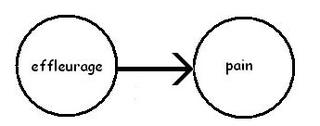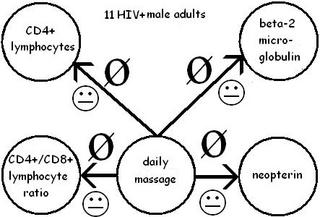In the Introduction, the authors describe the problem they want to study ("what?"), and the importance of the problem, or their motivation ("why?"). To show their connection to what other researchers have studied, and how their research fits into that big picture, they also do a brief review of the scientific literature.
Shor-Posner's "why":
In developing countries, where antiretroviral medications are not yet readily available to slow disease progression, massage therapy may have the potential to provide an important, safe, and sustainable form of immuno-stimulation.
Context: AIDS (Acquired Immune Deficiency Syndrome), caused by the human immunodeficiency virus (HIV), eventually destroys the immune system of the infected patient, leaving him or her vulnerable to infections that a healthy person could fight off.
AIDS is not an equal-opportunity killer--people in the developed world have access to many resources that people in the developing world do not. Early diagnosis, access to drugs, good nutrition--all of these, while they cannot cure AIDS, can dramatically improve quality of life and length of life expectancy for people who have access to them. By contrast, if people do not have access to them, these factors can magnify each other--getting diagnosed late means less time on drugs (if they are available at all), and poor nutrition gives the immune system another obstacle to fight. So it is not particularly surprising that infection and death rates for AIDS infections are higher out of proportion in the developing world, compared to the developed world.
Although accurate data is difficult to come by,
The the Joint United Nations Programme on HIV/AIDS estimates that anywhere from 270,000 to 760,000 people in the Caribbean are living with HIV/AIDS. They estimate that in the last year, around 52,000 people got infected with the disease, and 35,000 people died from it.
According to Claire-Cecile Pierre, MD of the Cambridge Health Alliance, in 2003, somewhere from 350,000 to 590,000 adults and children were estimated to be living with HIV/AIDS in the Caribbean, while from 790,000 to 1.2 million were estimated to be living with HIV/AIDS in North America. They estimate that in that same year, from 30,000 to 50,000 adults and children with HIV/AIDS died in the Caribbean, and from 12,000 to 18,000 died in North America.
Although those numbers are approximate, we can make a few scenarios from them. Let's first assume the worst-case scenario: the most infections and the most deaths. For the Caribbean, that means 50,000 dead out of 590,000 infected (8.5%), and for North America, that means 18,000 dead out of 1.2 million infected (1.5%).
Now let's figure the best-case scenario: the fewest infections and the fewest deaths: For the Caribbean, that is 30,000 dead out of 350,000 infected (%), while for North America, that is 12,000 dead out of 790,000 infected (%).
Best-case scenario: North America--1.5, Caribbean--8.6%
Worst-case scenario: North America--1.5%, Caribbean--8.5%
Despite the differing possible minimum and maximum numbers, the rates are fairly consistent. In other words, adults and children living with HIV/AIDS in the Caribbean die at 5.67 times the rate (8.5%/1.5%) that their North American counterparts do.
It is in this context of higher rates of disease and death, and less access to resources such as standard drug therapy that Shor-Posner and her team decided to investigate the effects of massage on the immune system of Dominican children infected with HIV-1.
Shor-Posner's "what" (her team's research question):
The present study investigated the effectiveness of massage therapy in enhancing immune status in HIV-1 infected children living in the Dominican Republic, who are particularly vulnerable to rapid disease progression due to the limited access to antiretroviral therapies, prevalence of malnutrition, and increased risk of opportunistic infection.
Shor-Posner's literature review ("what other researchers have done to date"):
Daily massage therapy has been shown to enhance natural killer cytotoxic capacity in HIV+ adults (Ironson et al., 1996) and improve markers of disease progression (CD4 cell count, CD4/CD8 ratio) in adolescents who received massage treatment twice weekly for 12 weeks (Diego et al., 2001). Less frequent (once weekly) massage, however, has not been associated with immune improvement in HIV infected persons (Birk et al., 2000).
I'm going to reinterpret this in the form of a
concept graph, a way of visually summarizing and representing complex information. In our concept graphs, the circles will represent "things", such as "effleurage" and "pain" [nouns]:

Adding lines between the circles will represent relationships, such as "decreases" or "increases" [verbs]. The line starts at the thing that causes the relationship, and points at the thing which is affected by the relationship:

So far, we have two things (effleurage and pain), and some kind of relationship between them, but we don't know what that relationship is. We need some kind of relationship description to clarify this question, so we add a "down" arrown to mean "decreases". The following concept graph means "effleurage decreases pain".

We're almost there--the last thing we need is an indicator of the meaning of that relationship. After all, the same thing can mean different things in different contexts: lowering the blood pressure of someone with high blood pressure is a desireable result, for example, while it's not so desireable for someone whose blood pressure is already low. So we add an indicator (a "smiley-face") to indicate that this "decreases" relationship between effleurage and pain is a good outcome:

So applying those ideas to a concept graph of Shor-Posner's literature review, we get the following overview of the effect of massage on immune system markers:
Ironson 1996:


Some positive results, some neutral--the zeroes show that the massage had no effect, and the neutral faces mean that that fact is neither positive nor negative.
Birk 2000, neutral results:

and Diego 2001, positive results:

So in this post, we have learned:
- the researchers' motivation: the HIV+ children's lack of access to antiretroviral drugs
- their research question: to study the effectiveness of massage in promoting the children's immune systems
- the positive indications and the neutral indications in the research literature--why they think that massage may be an effective intervention, based on the work that has gone before
It's been pretty slow going, and if you have stuck with it this far, I appreciate it! But remember, as these concepts get more familiar to you, you'll be able to read these posts and the associated articles faster and faster. They won't all be so slow as our first couple of ones.
Here's the Dominican Republic, where the study took place, in relationship to Miami, where the research group is located:


(Source:
http://worldatlas.com/webimage/countrys/namerica/caribb/do.htm)











